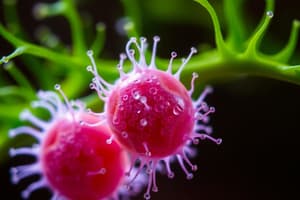Podcast
Questions and Answers
What are the four major classes of biological macromolecules?
What are the four major classes of biological macromolecules?
- Enzymes, lipids, proteins, and nucleic acids
- Carbohydrates, lipids, proteins, and nucleic acids (correct)
- Carbohydrates, lipids, antioxidants, and vitamins
- Proteins, minerals, nucleic acids, and carbohydrates
Which biological macromolecule serves as energy storage in cells?
Which biological macromolecule serves as energy storage in cells?
- Proteins
- Carbohydrates
- Lipids (correct)
- Nucleic acids
What is the role of nucleic acids in cells?
What is the role of nucleic acids in cells?
- Cellular transport
- Structural components
- Energy storage
- Genetic information storage (correct)
Which biological macromolecule consists of amino acids?
Which biological macromolecule consists of amino acids?
What is the function of lipids in cells?
What is the function of lipids in cells?
During protein synthesis, how are amino acids joined together?
During protein synthesis, how are amino acids joined together?
Which of the following is a key focus of the scientific study of ecology?
Which of the following is a key focus of the scientific study of ecology?
What is the basic unit of life that is studied in cell biology?
What is the basic unit of life that is studied in cell biology?
Which of the following is an example of a symbiotic relationship studied in ecology?
Which of the following is an example of a symbiotic relationship studied in ecology?
Which abiotic factor can influence the distribution and abundance of species in an ecosystem, as studied in ecology?
Which abiotic factor can influence the distribution and abundance of species in an ecosystem, as studied in ecology?
What is the relationship between predators and prey in an ecosystem, as studied in ecology?
What is the relationship between predators and prey in an ecosystem, as studied in ecology?
Which of the following is a key focus of the study of biological macromolecules?
Which of the following is a key focus of the study of biological macromolecules?
Flashcards are hidden until you start studying
Study Notes
Biology: Ecology, Cell Biology, and Biological Macromolecules
In the study of life sciences, various subtopics arise, including ecology, cell biology, and biological macromolecules. This article explores these interconnected fields, highlighting the importance of each and delving deeper into the concepts that define them.
Ecology
Ecology refers to the scientific study of interactions among organisms and their environment. It focuses on the relationships between species within ecosystems, exploring factors such as population dynamics, food webs, symbiotic relationships, and the balance between predator and prey populations.
One crucial aspect of ecology is understanding the role of organisms within ecosystems. Predators and prey have coevolved over time, leading to adaptations that enhance survival. Symbiotic relationships, where organisms live with one another in close proximity, offer mutual benefits, allowing each species to thrive in its respective habitat. Furthermore, ecologists study abiotic factors, such as climate, soil composition, air quality, and water supplies, to understand how they influence the distribution and abundance of species in a given area.
Cell Biology
Cell biology, also known as cytology, involves studying individual cells and their components. Cells are the basic unit of life, making up all living organisms. Within cell biology, scientists investigate the structure, function, and behavior of cells, including their membranes, cytoplasm, mitochondria, ribosomes, and DNA.
Understanding cell biology is essential for comprehending life at a fundamental level. It helps us recognize patterns across different species and identify connections between cellular processes and overall organismal behaviors. Moreover, this field has led to numerous advancements in medicine, as knowledge of cellular mechanisms has enabled the development of treatments for diseases such as cancer, Alzheimer's, and diabetes.
Biological Macromolecules
Biological macromolecules are large, complex molecules necessary for life. They are organic, containing carbon, hydrogen, oxygen, nitrogen, phosphorus, sulfur, and other minor elements. There are four major classes of biological macromolecules: carbohydrates, lipids, proteins, and nucleic acids.
-
Carbohydrates: Also known as saccharides, carbohydrates are biological macromolecules consisting of carbon, hydrogen, and oxygen. Carbohydrates serve diverse functions in cells, such as providing energy, serving as structural components, and participating in cell communication pathways.
-
Proteins: Proteins are complex biological macromolecules made up of amino acids. They perform a variety of functions in cells, including acting as enzymes, facilitating cellular transport, participating in immune responses, and playing roles in cell division and growth.
-
Lipids: Lipids are organic molecules that are nonpolar and insoluble in water. They store energy in cells, act as structural components of cell membranes, and participate in cell signaling processes.
-
Nucleic Acids: Nucleic acids, specifically DNA and RNA, are molecules made up of repeating units of nucleotides. DNA carries the genetic information of a cell, while RNA serves various roles in transcribing and translating genetic information.
These macromolecules are crucial for maintaining life at every level, from the smallest bacterium to the largest multicellular organism. Their unique structures allow for a range of functions that enable cells to grow, reproduce, respond to stimuli, and adapt to their environments.
Amino Acids and Peptide Bonds
Amino acids are the building blocks of proteins. They consist of a central carbon atom, an amino group (-NH2), a carboxyl group (-COOH), and a variable side chain (R-group). During protein synthesis, amino acids are joined together by peptide bonds, forming long chains that fold into specific three-dimensional structures determined by their sequence.
Nucleotides and the Central Dogma of Genetics
Nucleotides are the building blocks of nucleic acids. They consist of a pentose sugar, a phosphate group, and a nitrogenous base. In DNA, there are four nucleotides: adenine (A), guanine (G), cytosine (C), and thymine (T). In RNA, uracil (U) replaces thymine. The Watson-Crick model describes the structure of DNA and explains its base pairing rules. The central dogma of genetics states that information flows from DNA to RNA to proteins.
Conclusion
In summary, ecology, cell biology, and biological macromolecules are all integral parts of the broader field of biology. Ecology examines the interactions between organisms and their environment, while cell biology investigates the structure and function of individual cells. Biological macromolecules, including carbohydrates, lipids, proteins, and nucleic acids, are fundamental components of life, enabling various cellular processes and driving evolution. Together, these areas of study provide a comprehensive understanding of life at multiple levels, from the smallest molecules to entire ecosystems.
Studying That Suits You
Use AI to generate personalized quizzes and flashcards to suit your learning preferences.




